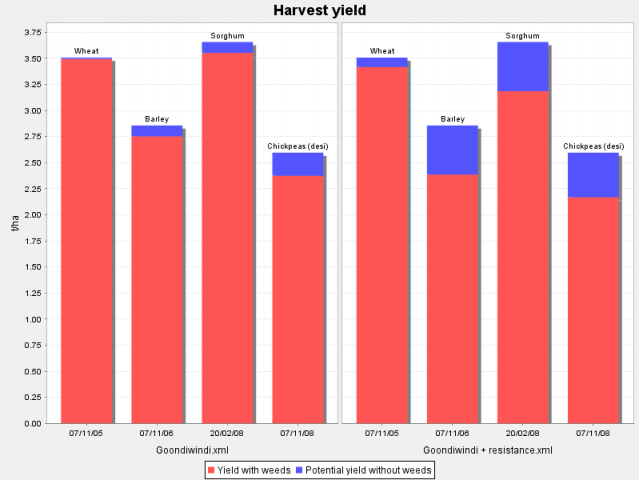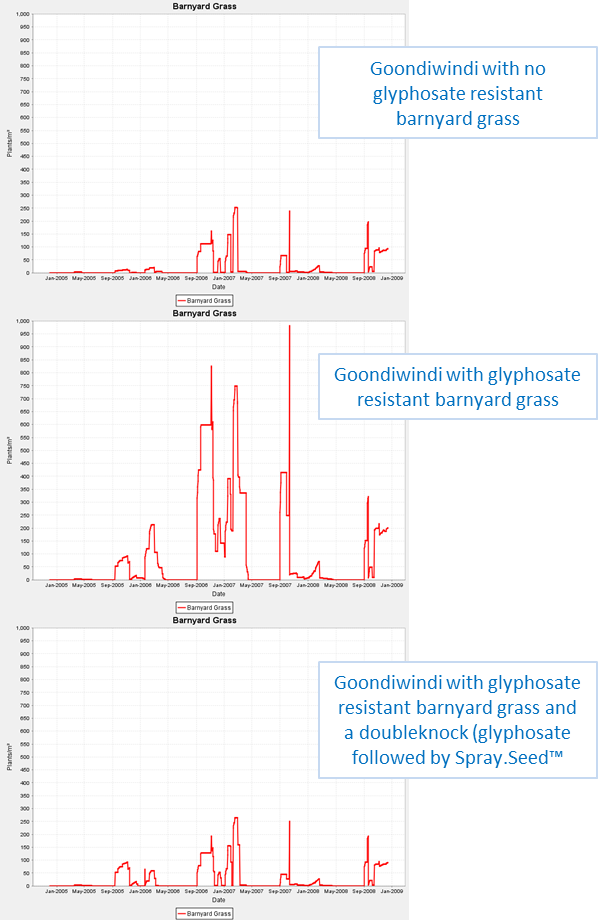Goondiwindi, QLD - glyphosate resistance in barnyard grass
This Queensland scenario is set in Goondiwindi between 2005 and 2008.
This is a wheat - barley - sorghum - chickpea rotation with a long fallow between barley and sorghum. The main weed is barnyard grass.
In the original scenario, barnyard grass is suceptible to glyphosate. It is used heavily to control barnyard grass with repeated application throughout the four years (see Table 4 below for management events).
In the modified scenario, the same spray applications of glyphosate are used but barnyard grass develops resistance to glyphosate, beginning at 30% resistance in 2005 and increasing to 60% resistance by 2008. In a final scenario, a double knock (a glyphosate followed by a Spray.Seed™ application 3- 10 days later) is used at least three times during the short and long fallows beteen crop rotations.
| Date | Management events for the original and modified scenarios (with glyphosate resistance) | Management events for the final scenario showing the double knock |
|---|---|---|
| 03/03/05 | Spray: Glyphosate 450 | - |
| 20/04/05 | Spray: Glyphosate 450 | - |
| 20/06/05 | Sow: Wheat, knifepoint seeding | - |
| 20/06/05 | Spray: Glyphosate 450 | - |
| 20/07/05 | Spray: Axial | - |
| 20/08/05 | Spray: Tordon 242 | - |
| 07/11/05 | Harvest: Wheat harvested, all chaff spread/normal harvest used | - |
| 15/11/05 | Spray: Glyphosate 450 | - |
| 15/12/05 | Spray: Glyphosate 450 | - |
| 20/12/05 | - | Spray: SpraySeed |
| 18/01/06 | Spray: Glyphosate 450 | - |
| 21/01/06 | - | Spray: SpraySeed |
| 03/03/06 | Spray: Glyphosate 450 | - |
| 08/03/05 | - | Spray: SpraySeed |
| 05/04/06 | Spray: Glyphosate 450 | - |
| 14/06/06 | Spray: Glyphosate 450 | - |
| 15/06/06 | Sow: Barley, knifepoint seeding | - |
| 20/07/06 | Spray: Axial | - |
| 20/08/06 | Spray: Tordon 242 | - |
| 07/11/06 | Harvest: Barley harvested, all chaff spread/normal harvest used | - |
| 15/11/06 | Spray: Glyphosate 450 | - |
| 20/11/06 | - | Spray: SpraySeed |
| 15/12/06 | Spray: Glyphosate 450 | - |
| 20/12/06 | - | Spray: SpraySeed |
| 30/01/07 | Spray: Glyphosate 450 | - |
| 03/02/07 | - | Spray: SpraySeed |
| 01/03/07 | Spray: Glyphosate 450 | - |
| 10/03/07 | - | Spray: SpraySeed |
| 14/04/07 | Spray: Glyphosate 450 | - |
| 28/05/07 | Spray: Glyphosate 450 | - |
| 20/07/07 | Spray: Glyphosate 450 | - |
| 30/09/07 | Spray: Glyphosate 450 | - |
| 12/10/07 | Sow: Sorghum, knifepoint seeding | - |
| 13/10/07 | Spray: Dual Gold/Atrazine/paraquat | - |
| 15/11/07 | Spray: Atrazine/Starane post-em | - |
| 20/02/08 | Harvest: Sorghum harvested, dessication used | - |
| 15/04/08 | Spray: Glyphosate 450 | - |
| 29/05/08 | Spray: Glyphosate 450 | - |
| 01/06/08 | Sow: Chickpeas (desi), knifepoint seeding | - |
| 02/06/08 | Spray: Simazine/Balance | - |
| 20/09/08 | Spray: Verdict | - |
| 07/10/08 | Spray: Crop-top Gramoxone | - |
| 07/11/08 | Harvest: Chickpeas (desi) harvested, dessication used | - |
What happens when barnyard grass develops resistance to glyphosate?
In the first scenario (Figure 7 - left, Figure 8 - top), there is no glyphosate resistance in barnyard grass and it is controlled well. In the second scenario, (Figure 7 - right and Figure 8 - middle), the barnyard grass develops resistance to glyphosate, beginning at 30% resistance in 2005 and increasing to 60% resistance by 2008. There is a substantial yield loss.

But by looking at the plant numbers of barnyard grass (Figure 8) in all of the scenarios, you can see that although barnyard grass is germinating each year, it is controlled by glyphosate in the original scenario (where barnyard grass is susceptible) (top). When glyphosate resistance develops (modified scenario - middle) there are many more barnyard grass plants throughout the four years. By adding a doubleknock in the final scenario (bottom), the plant numbers are reduced and resemble the original scenario.

What can you do once barnyard grass is resistant to glyphosate?
There are many integrated weed management techniques that can be used (and are available in the Weed Seed Wizard). These might include:
- rotating herbicides (after doing a resistance test on the barnyard grass)
- increasing crop seeding rates for greater crop competition
- changing the ;crop rotation with different herbicide modes of action
- having a fallow year using different herbicides with different modes of action
- having a pastures phase with grazing
- incorporate cultivation into your system.
For more information refer to integrated weed management links in See also section or look at the Integrated Weed Management manual (External links) and discover how they may fit into your farm.


